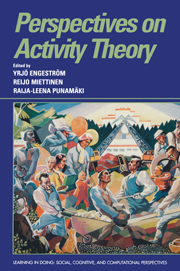Book contents
- Frontmatter
- Contents
- List of contributors
- Series foreword
- Introduction
- Part I Theoretical issues
- 1 Activity theory and individual and social transformation
- 2 The content and unsolved problems of activity theory
- 3 Knowledge as shared procedures
- 4 Activity theory in a new era
- 5 Society versus context in individual development: Does theory make a difference?
- 6 Cultural psychology: Some general principles and a concrete example
- 7 Laws, logics, and human activity
- 8 Collapse, creation, and continuity in Europe: How do people change?
- 9 Activity theory and the concept of integrative levels
- 10 The relevance to psychology of Antonio Gramsci's ideas on activity and common sense
- Part II Language and its acquisition
- Part III Play, learning, and instruction
- Part IV Technology and work
- Part V Therapy and addiction
- Author index
- Subject index
2 - The content and unsolved problems of activity theory
Published online by Cambridge University Press: 05 June 2012
- Frontmatter
- Contents
- List of contributors
- Series foreword
- Introduction
- Part I Theoretical issues
- 1 Activity theory and individual and social transformation
- 2 The content and unsolved problems of activity theory
- 3 Knowledge as shared procedures
- 4 Activity theory in a new era
- 5 Society versus context in individual development: Does theory make a difference?
- 6 Cultural psychology: Some general principles and a concrete example
- 7 Laws, logics, and human activity
- 8 Collapse, creation, and continuity in Europe: How do people change?
- 9 Activity theory and the concept of integrative levels
- 10 The relevance to psychology of Antonio Gramsci's ideas on activity and common sense
- Part II Language and its acquisition
- Part III Play, learning, and instruction
- Part IV Technology and work
- Part V Therapy and addiction
- Author index
- Subject index
Summary
Introduction
All the humanities have for their subjects different aspects of human activity. At present they have to face a great number of acute unsolved problems. But before stating those problems and looking for ways to solve them, it is important to explain the basic concept of activity as formulated by the followers of activity theory.
Activity is a specific form of the societal existence of humans consisting of purposeful changing of natural and social reality. In contrast to the laws of nature, societal laws manifest themselves only through human activity that constructs new forms and features of reality, thus turning the initial material into products. Any activity carried out by a subject includes goals, means, the process of molding the object, and the results. In fulfilling the activity, the subjects also change and develop themselves.
The goals of activity manifest themselves as images of the foreseen result of the creative effort. The transforming and purposeful character of activity allows the subject to step beyond the frames of a given situation and to see it in a wider historical and societal context. It makes it possible for the subject to find means that go beyond the given possibilities. Activity permanently and limitlessly overcomes all the “programs” on which it is based. That is why it cannot be limited to changing reality according to the stable cultural norms. Activity is, in principle, open and universal; it should be taken as the form of historical and cultural creativity.
- Type
- Chapter
- Information
- Perspectives on Activity Theory , pp. 39 - 52Publisher: Cambridge University PressPrint publication year: 1999
- 70
- Cited by



